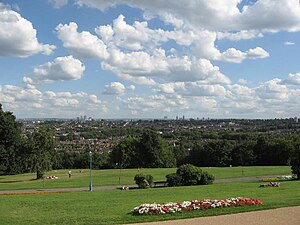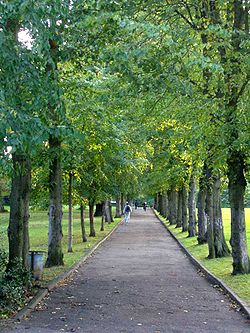Alexandra Park, Middlesex: Difference between revisions
mNo edit summary |
|||
| Line 4: | Line 4: | ||
'''Alexandra Park''' is a landscaped public park of 200 acres extending eastwards from [[Alexandra Palace]] in [[Middlesex]]. It is bordered by the contiguous townscape of the metropolitan conurbation, by [[Hornsey]], [[Muswell Hill]] and [[Wood Green]]. | '''Alexandra Park''' is a landscaped public park of 200 acres extending eastwards from [[Alexandra Palace]] in [[Middlesex]]. It is bordered by the contiguous townscape of the metropolitan conurbation, by [[Hornsey]], [[Muswell Hill]] and [[Wood Green]]. | ||
The park was laid out on the site of Tottenham Wood and the later Tottenham Wood Farm, as part of the development of Alexandra Palace as a 'People's Palace' for leisure and entertainment. The park and palace were named in 1863, the year of the marriage of Alexandra of Denmark to the Prince of Wales who became King Edward VII.<ref>{{Placenames|Mills|page=6}}</ref> | The park was laid out on the site of Tottenham Wood and the later Tottenham Wood Farm, as part of the development of Alexandra Palace as a 'People's Palace' for leisure and entertainment. The park and palace were named in 1863, the year of the marriage of Alexandra of Denmark to the Prince of Wales, who became King Edward VII.<ref>{{Placenames|Mills|page=6}}</ref> | ||
The landscaping and situation provide a diverse environment: Alexandra Park is split between hilly and flat ground, and the tree-lined hill has wide views from slopes and many areas of the relatively large hilltop. Of note is the view from [[Alexandra Palace]] which dominates the park, particularly its Panorama Room. On most days the Crystal Palace Transmitter and/or the [[North Downs]] in the midst of [[Surrey]] are visible. | The landscaping and situation provide a diverse environment: Alexandra Park is split between hilly and flat ground, and the tree-lined hill has wide views from slopes and many areas of the relatively large hilltop. Of note is the view from [[Alexandra Palace]] which dominates the park, particularly its Panorama Room. On most days the Crystal Palace Transmitter and/or the [[North Downs]] in the midst of [[Surrey]] are visible. | ||
From 1936 to 1981, the BBC transmitted television programmes from a tall mast built onto one of the towers of the palace. In 1980, most of the palace was gutted by a huge fire. The building has since been restored and is now a conference and exhibition centre. | From 1936 to 1981, the [[BBC]] transmitted television programmes from a tall mast built onto one of the towers of the palace. In 1980, most of the palace was gutted by a huge fire. The building has since been restored and is now a conference and exhibition centre. | ||
==Location== | ==Location== | ||
*Location map: {{wmap|51.59568|-0.12603}} | *Location map: {{wmap|51.59568|-0.12603|zoom=14}} | ||
*Streetmap: {{map|TQ299902}} | *Streetmap: {{map|TQ299902}} | ||
==History== | ==History== | ||
{{main|Alexandra Palace}} | {{main|Alexandra Palace}} | ||
The park was created in the 1850s as a private enterprise, to build an education, recreation and events venue: this was intended to rival the Crystal Palace on the [[Surrey]] / [[Kent]] border (where the Crystal Palace of the Great Exhibition of 1851 had been rebuilt). In 1900, the owners planned to the redevelop the park and palace, and so local enthusiasts subscribed together to buy it to preserve Alexandra Palace and its park from development, and obtained an Act of Parliament which created the Alexandra Palace and Park Trust as to which the Trustees were bound to maintain the Palace and Park and make them available for the free use and recreation of the public forever. | The park was created in the 1850s as a private enterprise, to build an education, recreation and events venue: this was intended to rival the Crystal Palace on the [[Surrey]] / [[Kent]] border (where [[the Crystal Palace]] of the Great Exhibition of 1851 had been rebuilt). In 1900, the owners planned to the redevelop the park and palace, and so local enthusiasts subscribed together to buy it to preserve Alexandra Palace and its park from development, and obtained an Act of Parliament which created the Alexandra Palace and Park Trust as to which the Trustees were bound to maintain the Palace and Park and make them available for the free use and recreation of the public forever. | ||
Until September 1970, the park hosted horse racing, including many evening meetings that were televised by the BBC. The Alexandra Park Racecourse on the plain below the palace was nicknamed "the Frying Pan" owing to its shape, featuring an ornate Victorian grandstand and cast-iron railings. For eight decades the whole venue had up to three stations, one of which was a tram station, to enable more visitors. Its most prestigious race was the London Cup. Alexandra Park Cricket Club and Football Club occupy most of the former site, which are thus sporting facilities for the local community.<ref>[http://www.alexandraparkcricketclub.com/ Alexandra Park Cricket Club]</ref><ref>http://www.alexandraparkfc.co.uk/ Alexandra Park Football Club]</ref> | Until September 1970, the park hosted horse racing, including many evening meetings that were televised by the BBC. The Alexandra Park Racecourse on the plain below the palace was nicknamed "the Frying Pan" owing to its shape, featuring an ornate Victorian grandstand and cast-iron railings. For eight decades the whole venue had up to three stations, one of which was a tram station, to enable more visitors. Its most prestigious race was the London Cup. Alexandra Park Cricket Club and Football Club occupy most of the former site, which are thus sporting facilities for the local community.<ref>[http://www.alexandraparkcricketclub.com/ Alexandra Park Cricket Club]</ref><ref>http://www.alexandraparkfc.co.uk/ Alexandra Park Football Club]</ref> | ||
Latest revision as of 13:15, 13 October 2020


Alexandra Park is a landscaped public park of 200 acres extending eastwards from Alexandra Palace in Middlesex. It is bordered by the contiguous townscape of the metropolitan conurbation, by Hornsey, Muswell Hill and Wood Green.
The park was laid out on the site of Tottenham Wood and the later Tottenham Wood Farm, as part of the development of Alexandra Palace as a 'People's Palace' for leisure and entertainment. The park and palace were named in 1863, the year of the marriage of Alexandra of Denmark to the Prince of Wales, who became King Edward VII.[1]
The landscaping and situation provide a diverse environment: Alexandra Park is split between hilly and flat ground, and the tree-lined hill has wide views from slopes and many areas of the relatively large hilltop. Of note is the view from Alexandra Palace which dominates the park, particularly its Panorama Room. On most days the Crystal Palace Transmitter and/or the North Downs in the midst of Surrey are visible.
From 1936 to 1981, the BBC transmitted television programmes from a tall mast built onto one of the towers of the palace. In 1980, most of the palace was gutted by a huge fire. The building has since been restored and is now a conference and exhibition centre.
Location
- Location map: 51°35’44"N, 0°7’34"W
- Streetmap: TQ299902
History
- Main article: Alexandra Palace
The park was created in the 1850s as a private enterprise, to build an education, recreation and events venue: this was intended to rival the Crystal Palace on the Surrey / Kent border (where the Crystal Palace of the Great Exhibition of 1851 had been rebuilt). In 1900, the owners planned to the redevelop the park and palace, and so local enthusiasts subscribed together to buy it to preserve Alexandra Palace and its park from development, and obtained an Act of Parliament which created the Alexandra Palace and Park Trust as to which the Trustees were bound to maintain the Palace and Park and make them available for the free use and recreation of the public forever.
Until September 1970, the park hosted horse racing, including many evening meetings that were televised by the BBC. The Alexandra Park Racecourse on the plain below the palace was nicknamed "the Frying Pan" owing to its shape, featuring an ornate Victorian grandstand and cast-iron railings. For eight decades the whole venue had up to three stations, one of which was a tram station, to enable more visitors. Its most prestigious race was the London Cup. Alexandra Park Cricket Club and Football Club occupy most of the former site, which are thus sporting facilities for the local community.[2][3]
A medium-sized lake attracts a variety of waterfowl in all seasons, and used to have a large enclosure housing a small herd of fallow deer.[4] The deer were moved to Devon early 2016.[5]
The Park was declared a Local Nature Reserve in 2013,[6] and is also a 'Site of Borough Importance for Nature Conservation, Grade 1'.
Events
The Park hosts a variety of events throughout the year; food, craft and beer festivals, a summer festival, a fireworks festival in November and a weekly Parkrun each Saturday morning.[7]
The Friends of Alexandra Park organise walks, such as fungi, tree, wild flower, history and bat.
At the foot of Muswell Hill, the park is host to a farmers market most weeks.[8]
Outside links
| ("Wikimedia Commons" has material about Alexandra Park, Middlesex) |
References
- ↑ Place-Names, page 6
- ↑ Alexandra Park Cricket Club
- ↑ http://www.alexandraparkfc.co.uk/ Alexandra Park Football Club]
- ↑ deer Animals: Alexandra Palace
- ↑ 'Alexandra Park deer set to move to greener pastures': Ham & High, 21 January 2016
- ↑ "Alexandra Park". Natural England. 20 March 2014. http://www.lnr.naturalengland.org.uk/Special/lnr/lnr_details.asp?C=17&N=&ID=1770. Retrieved 9 April 2014.
- ↑ http://www.parkrun.org.uk/allypally/ Parkrun
- ↑ https://weareccfm.com/city-country-farmers-markets/market-profiles/alexandra-palace-market/ farmers market
